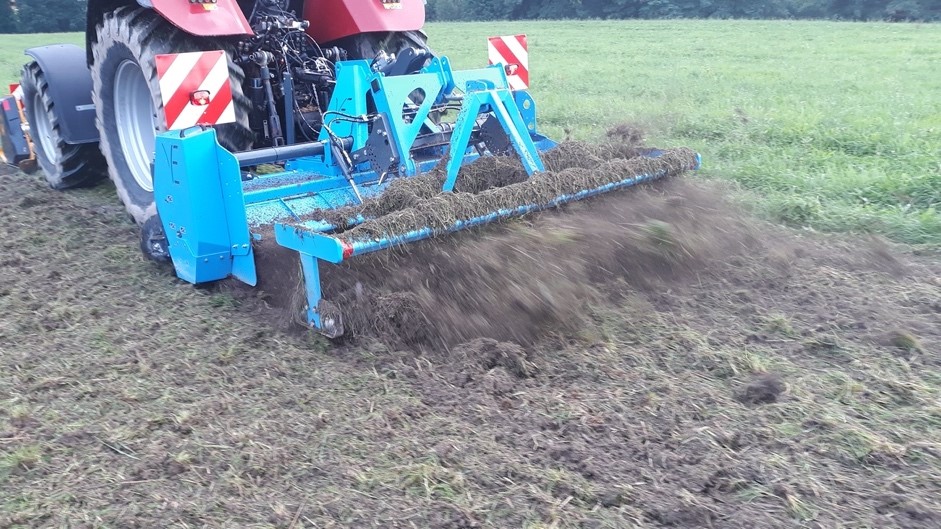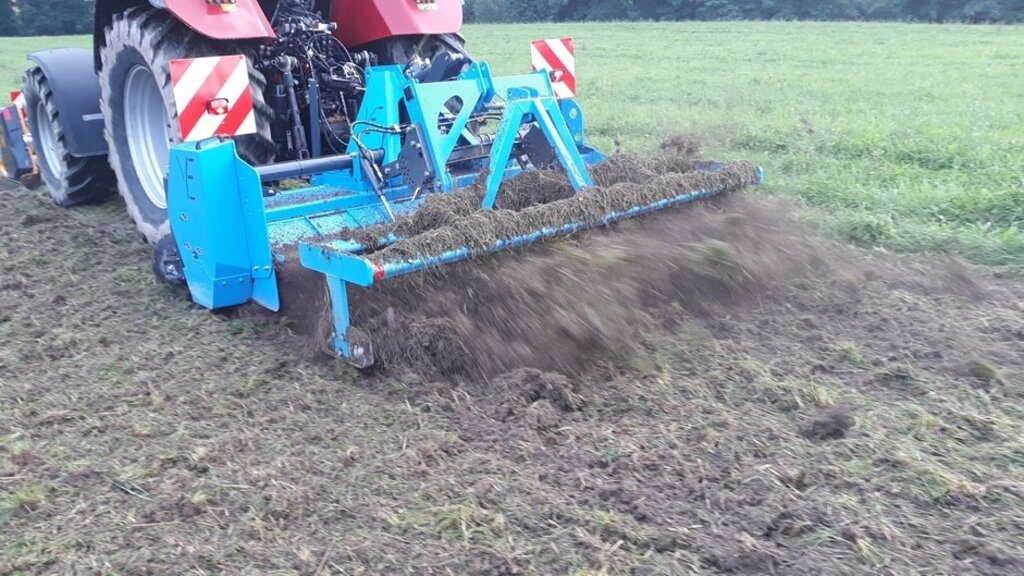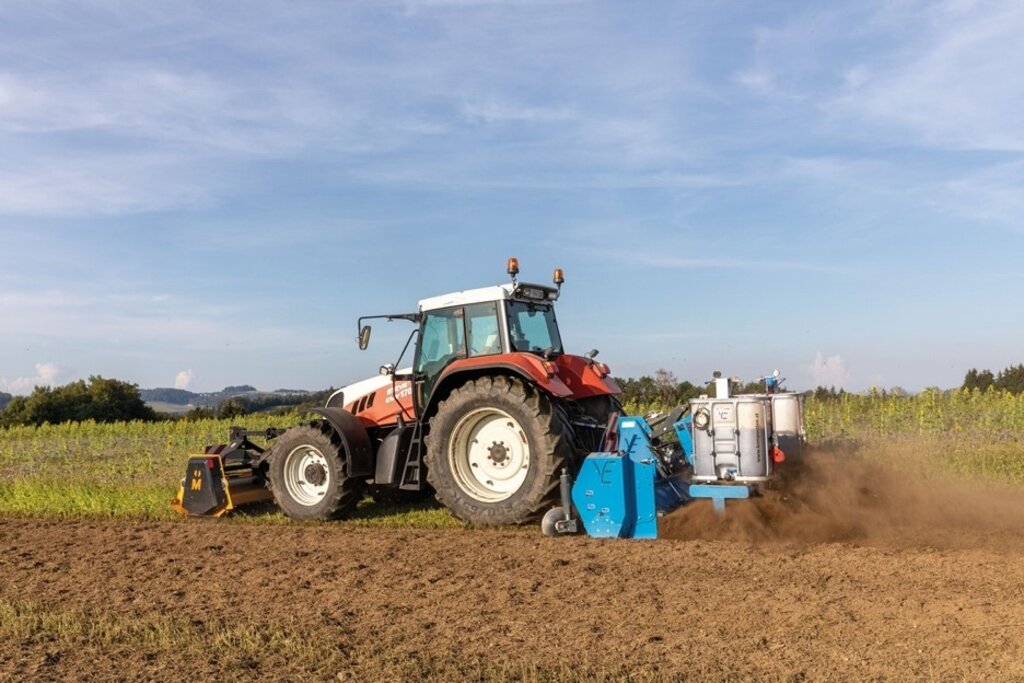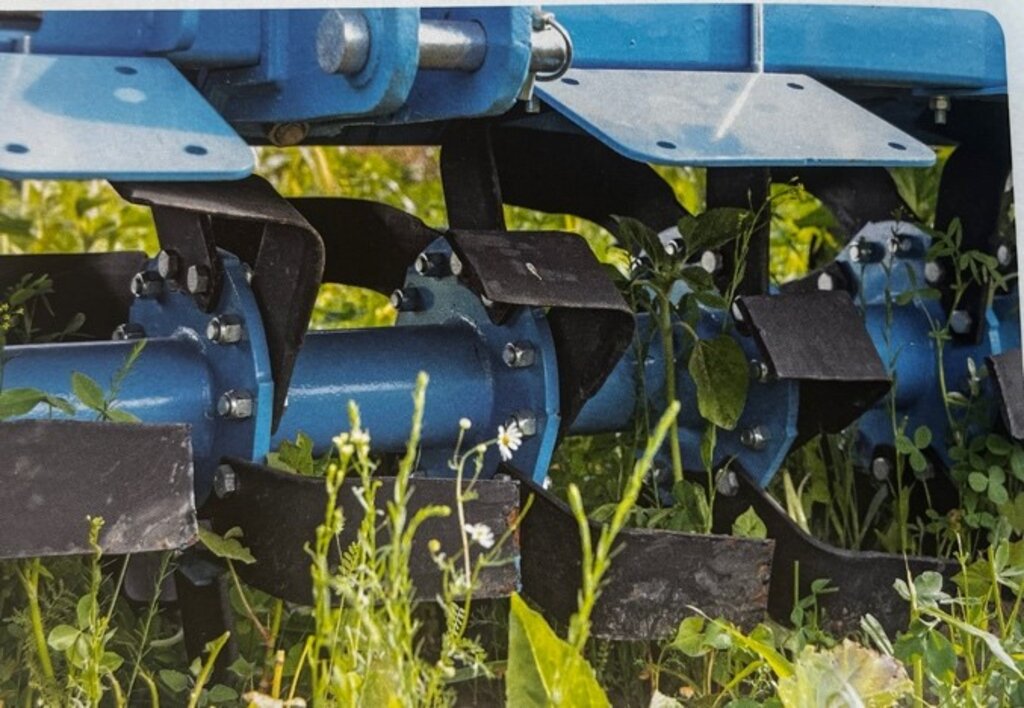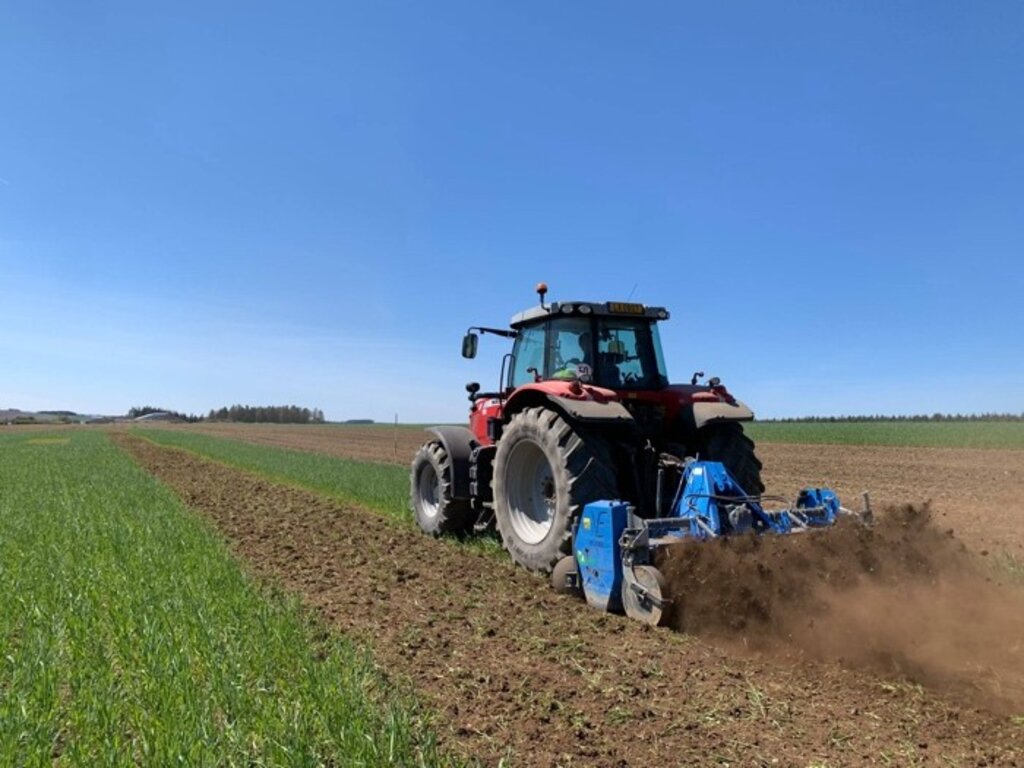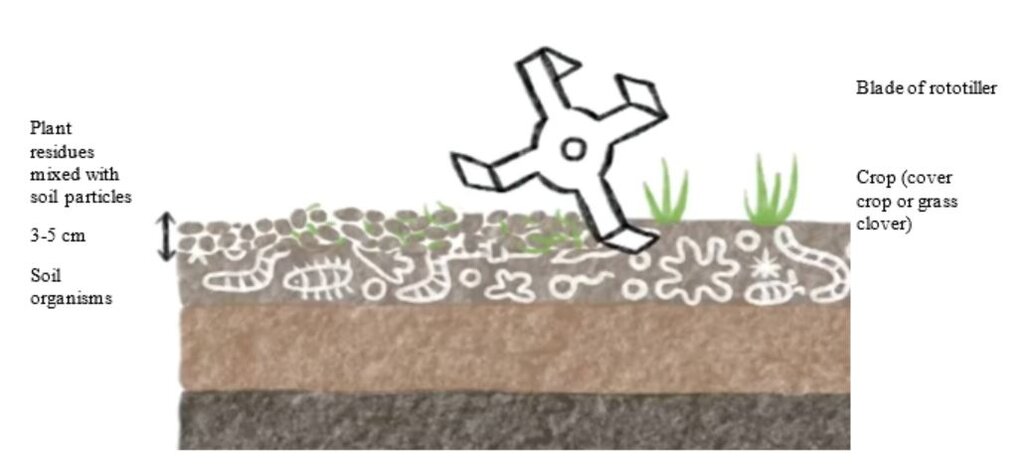Shallow rotary tillage with microbial digestion [卢森堡]
- 创建:
- 更新:
- 编制者: Alan Radbourne
- 编辑者: –
- 审查者: William Critchley, Rima Mekdaschi Studer
Flächenrotte
technologies_6878 - 卢森堡
查看章节
全部展开 全部收起1. 一般信息
1.2 参与该技术评估和文件编制的资源人员和机构的联系方式
关键资源人
SLM专业人员:
Mangen Michèle
Lycée technique Agricole (LTA)
卢森堡
SLM专业人员:
Ruf Thorsten
IBLA institute fir biologesch Landwirtschaft an Agrarkultur Lëtzebuerg
卢森堡
土地使用者:
Rossler Daniel
Farmer
卢森堡
有助于对技术进行记录/评估的项目名称(如相关)
European Interreg project FABulous Farmers1.3 关于使用通过WOCAT记录的数据的条件
编制者和关键资源人员接受有关使用通过WOCAT记录数据的条件。:
是
1.4 所述技术的可持续性声明
这里所描述的技术在土地退化方面是否存在问题,导致无法被认为是一种可持续的土地管理技术?:
否
2. SLM技术的说明
2.1 技术简介
技术定义:
Shallow rotary tillage with microbial digestion is a technique that is used to destroy cover crops and to manage stubble. The plant material is broken down to small pieces and incorporated into the surface layer of the soil. During the process bacteria and microbes are added to break down the plant material.
2.2 技术的详细说明
说明:
The use of the herbicide glyphosate for terminating catch/ cover crops or field forage is increasingly coming under criticism. Simultaneously there is a movement towards farming methods that preserve soil health by reducing deep tillage. Thus, farmers have developed a surface rotting system that protects soil while safely eliminating a cover crop. “Shallow rotary tillage with microbial digestion” is a technique that is used to destroy cover crops and to manage stubble. Overwintering catch crops/undersown plants or field forage are turned over in spring or autumn. The plant material is broken down to small pieces and incorporated into the surface layer of the soil (around 5 cm deep). By use of a field rototiller, the vegetation is mechanically destroyed and mixed with the soil particles. Depending on the activity of organisms in the soil, microorganisms may then be introduced to accelerate the decomposition process of the plant material. A second pass may be required after 7- 14 days. Aerobic decomposition of the plant material takes place on the surface/ within the top layer of the soil. The advantages of this surface rotting can be summarised as follows:
•No synthetic agents are used.
•The soil is not inverted but only superficially mixed.
•The soil structure and its pore system are preserved.
•Organic material is introduced into the soil and thus soil organisms are promoted.
The challenge with surface rotting is the weather. The soil must be sufficiently dry to avoid creating smear layers, but if it is too dry, the fuel input to power the machine increases. However, if the weather is too wet after rototilling, there is a risk of re-growth of the plants. The blades of the tiller must be sufficiently sharp to cut the vegetative core of the plants well. The use of effective microorganisms is not yet scientifically proven - and the price of these products is high: some farmers even produce their own microbially-rich “compost tea”.
2.3 技术照片
2.4 技术视频
注释、简短说明:
https://www.youtube.com/watch?v=gig2fknIpXM
日期:
01/04/2020
位置:
Luxemburg
2.5 已应用该技术的、本评估所涵盖的国家/地区/地点
国家:
卢森堡
区域/州/省:
Ösling
具体说明该技术的分布:
- 均匀地分布在一个区域
如果不知道精确的区域,请注明大致覆盖的区域:
- 1-10 平方千米
技术现场是否位于永久保护区?:
否
Map
×2.6 实施日期
注明实施年份:
2020
2.7 技术介绍
详细说明该技术是如何引入的:
- 通过土地使用者的创新
- 通过项目/外部干预
注释(项目类型等):
Developed through farmer's innovative idea to trial this system, and supported as part of the FABulous farmers project
3. SLM技术的分类
3.1 该技术的主要目的
- 改良生产
- 减少、预防、恢复土地退化
- 创造有益的经济影响
3.2 应用该技术的当前土地利用类型
同一土地单元内混合使用的土地::
否

农田
- 一年一作
- 多年一作(非木材)
每年的生长季节数:
- 1
采用间作制度了吗?:
是
采用轮作制度了吗?:
是
3.3 由于技术的实施,土地使用是否发生了变化?
由于技术的实施,土地使用是否发生了变化?:
- 否(继续问题3.4)
3.4 供水
该技术所应用土地的供水:
- 雨养
3.5 该技术所属的SLM组
- 改良的地面/植被覆盖
- 最小的土壤扰动
3.6 包含该技术的可持续土地管理措施

农艺措施
- A2:有机质/土壤肥力
3.7 该技术强调的主要土地退化类型

土壤水蚀
- Wt:表土流失/地表侵蚀
- Wg:冲沟侵蚀/沟蚀

物理性土壤退化
- Pk:熟化和结壳

水质恶化
- Hq:地下水水质下降
3.8 防止、减少或恢复土地退化
具体数量名该技术与土地退化有关的目标:
- 防止土地退化
- 减少土地退化
4. 技术规范、实施活动、投入和成本
4.1 该技术的技术图纸
技术规范(与技术图纸相关):
Tillage depth: 5 cm
Speed of tractor: depending on soil type and soil conditions
Timing: Autumn or Spring before sowing of main crop
Number of applications: max 2
作者:
Michèle Mangen
日期:
01/04/2023
4.2 有关投入和成本计算的一般信息
具体说明成本和投入是如何计算的:
- 每个技术区域
注明尺寸和面积单位:
1ha
如果使用本地面积单位,注明转换系数为1公顷(例如1公顷=2.47英亩):1公顷=:
2.4 acres
其它/国家货币(具体说明):
Eur
如相关,注明美元与当地货币的汇率(例如1美元=79.9巴西雷亚尔):1美元=:
0.91
注明雇用劳工的每日平均工资成本:
280
4.5 维护/经常性活动
| 活动 | 时间/频率 | |
|---|---|---|
| 1. | Change blades of rototiller | Depends on soil type and amount of stones in the soil. |
| 2. | Agronomic: first tillage of field | Before sowing main crop |
| 3. | Agronomic: second tillage of field (optional) | Before sowing main crop |
注释:
Applying effective microorganisms is done during tillage. If effective microorganisms are bought no time is needed for production. If applying "compost tea" then time for preparation has to be included
4.6 维护/经常性活动所需要的费用和投入(每年)
| 对投入进行具体说明 | 单位 | 数量 | 单位成本 | 每项投入的总成本 | 土地使用者承担的成本% | |
|---|---|---|---|---|---|---|
| 设备 | Tractor+Rototiller+labour | ha | 1.0 | 105.0 | 105.0 | 100.0 |
| 肥料和杀菌剂 | Effective microorganisms (EM) | litre | 150.0 | 1.5 | 225.0 | 100.0 |
| 其它 | Consumables (usage of tillers) | ha | 1.0 | 45.0 | 45.0 | 33.0 |
| 技术维护所需总成本 | 375.0 | |||||
| 技术维护总成本,美元 | 412.09 | |||||
如果土地使用者负担的费用少于100%,请注明由谁负担其余费用:
Water fund grant
4.7 影响成本的最重要因素
描述影响成本的最决定性因素:
Soil type defines speed of tractor and thus fuel, labour and recurrent maintenance costs.
5. 自然和人文环境
5.1 气候
年降雨量
- < 250毫米
- 251-500毫米
- 501-750毫米
- 751-1,000毫米
- 1,001-1,500毫米
- 1,501-2,000毫米
- 2,001-3,000毫米
- 3,001-4,000毫米
- > 4,000毫米
指定年平均降雨量(若已知),单位为mm:
800.00
有关降雨的规范/注释:
October-January rainfall is > 75mm per month
March-April rainfall is lowest <70mm per month
Seasons with extreme heavy rainfalls (short and a lot of water are around May)
农业气候带
- 半湿润
5.2 地形
平均坡度:
- 水平(0-2%)
- 缓降(3-5%)
- 平缓(6-10%)
- 滚坡(11-15%)
- 崎岖(16-30%)
- 陡峭(31-60%)
- 非常陡峭(>60%)
地形:
- 高原/平原
- 山脊
- 山坡
- 山地斜坡
- 麓坡
- 谷底
垂直分布带:
- 0-100 m a.s.l.
- 101-500 m a.s.l.
- 501-1,000 m a.s.l.
- 1,001-1,500 m a.s.l.
- 1,501-2,000 m a.s.l.
- 2,001-2,500 m a.s.l.
- 2,501-3,000 m a.s.l.
- 3,001-4,000 m a.s.l.
- > 4,000 m a.s.l.
说明该技术是否专门应用于:
- 不相关
5.3 土壤
平均土层深度:
- 非常浅(0-20厘米)
- 浅(21-50厘米)
- 中等深度(51-80厘米)
- 深(81-120厘米)
- 非常深(> 120厘米)
土壤质地(表土):
- 粗粒/轻(砂质)
- 中粒(壤土、粉土)
土壤质地(地表以下> 20厘米):
- 粗粒/轻(砂质)
- 中粒(壤土、粉土)
表土有机质:
- 中(1-3%)
5.4 水资源可用性和质量
地下水位表:
5-50米
地表水的可用性:
好
水质(未处理):
良好饮用水
水质请参考::
地下水和地表水
水的盐度有问题吗?:
否
该区域正在发生洪水吗?:
否
5.5 生物多样性
物种多样性:
- 中等
栖息地多样性:
- 中等
5.6 应用该技术的土地使用者的特征
定栖或游牧:
- 定栖的
生产系统的市场定位:
- 商业/市场
非农收入:
- 低于全部收入的10%
相对财富水平:
- 丰富
- 非常丰富
个人或集体:
- 个人/家庭
机械化水平:
- 机械化/电动
性别:
- 女人
- 男人
土地使用者的年龄:
- 中年人
5.7 应用该技术的土地使用者使用的平均土地面积
- < 0.5 公顷
- 0.5-1 公顷
- 1-2 公顷
- 2-5公顷
- 5-15公顷
- 15-50公顷
- 50-100公顷
- 100-500公顷
- 500-1,000公顷
- 1,000-10,000公顷
- > 10,000公顷
这被认为是小规模、中规模还是大规模的(参照当地实际情况)?:
- 中等规模的
5.8 土地所有权、土地使用权和水使用权
土地所有权:
- 个人,未命名
土地使用权:
- 租赁
- 个人
用水权:
- 社区(有组织)
土地使用权是否基于传统的法律制度?:
是
5.9 进入服务和基础设施的通道
健康:
- 贫瘠
- 适度的
- 好
教育:
- 贫瘠
- 适度的
- 好
技术援助:
- 贫瘠
- 适度的
- 好
就业(例如非农):
- 贫瘠
- 适度的
- 好
市场:
- 贫瘠
- 适度的
- 好
能源:
- 贫瘠
- 适度的
- 好
道路和交通:
- 贫瘠
- 适度的
- 好
饮用水和卫生设施:
- 贫瘠
- 适度的
- 好
金融服务:
- 贫瘠
- 适度的
- 好
6. 影响和结论性说明
6.1 该技术的现场影响
社会经济效应
生产
作物生产
注释/具体说明:
Cover crop provides green manure for soil fertility
作物质量
土地管理
注释/具体说明:
Less crusting issues with better water retention in soil
收入和成本
农业投入费用
注释/具体说明:
Costs increased with undertaking new technology due to additional labour. Aim is to be cost neutral in future but using mechanical rather than chemical methods
工作量
注释/具体说明:
Takes more time
生态影响
水循环/径流
水量
注释/具体说明:
Better water retention in soil with cover crops
土壤
土壤水分
注释/具体说明:
Better water retention in soil with cover crops
土壤覆盖层
土壤流失
土壤结壳/密封
土壤压实
养分循环/补给
土壤有机物/地下C
生物多样性:植被、动物
植被覆盖
生物量/地上C
有益物种
减少气候和灾害风险
洪水影响
干旱影响
6.3 技术对渐变气候以及与气候相关的极端情况/灾害的暴露和敏感性(土地使用者认为的极端情况/灾害)
渐变气候
渐变气候
| 季节 | 增加或减少 | 该技术是如何应对的? | |
|---|---|---|---|
| 季节性温度 | 春季 | 增加 | 适度 |
| 季节性温度 | 秋季 | 增加 | 适度 |
| 季雨量 | 春季 | 减少 | 适度 |
| 季雨量 | 秋季 | 减少 | 适度 |
6.4 成本效益分析
技术收益与技术维护成本/经常性成本相比如何(从土地使用者的角度看)?
短期回报:
轻度消极
长期回报:
中性/平衡
6.5 技术采用
- 1-10%
在所有采用这项技术的人当中,有多少人是自发的,即未获得任何物质奖励/付款?:
- 91-100%
6.6 适应
最近是否对该技术进行了修改以适应不断变化的条件?:
否
6.7 该技术的优点/长处/机会
| 土地使用者眼中的长处/优势/机会 |
|---|
| Cover crop /fodder crop termination is without the use of glyphosate or the plough |
| Water retention capacity of the soil is increased (resilience to drought increased) |
| 编制者或其他关键资源人员认为的长处/优势/机会 |
|---|
| Soil health is increased. |
| Farmers independence of external inputs is decreased |
| Acceptance of field fodder and cover crops is increased |
6.8 技术的弱点/缺点/风险及其克服方法
| 土地使用者认为的弱点/缺点/风险 | 如何克服它们? |
|---|---|
| costs (fuel/time). | |
| timing and weather have a big impact on success | experience |
7. 参考和链接
7.1 信息的方法/来源
- 实地考察、实地调查
2
- 与土地使用者的访谈
2
- 与SLM专业人员/专家的访谈
1
(现场)数据是什么时候汇编的?:
01/04/2022
7.2 参考可用出版物
标题、作者、年份、ISBN:
Regenerative Landwirtschaft, Dietmar Näser, 2020, ISBN 978-8186-0695-4
可以从哪里获得?成本如何?
Ulmer.de 34,95€
7.3 链接到网络上的相关信息
标题/说明:
Home Page of a German advisor
URL:
https://www.regenerative-landwirtschaft.de/
标题/说明:
Swiss home page of regenerative agriculture
URL:
https://agrar.em-schweiz.ch/flaechenrotte
标题/说明:
Austrian homepage of equipment seller
URL:
http://www.ackerfräse.at/
链接和模块
全部展开 全部收起链接
无链接
模块
无模块


